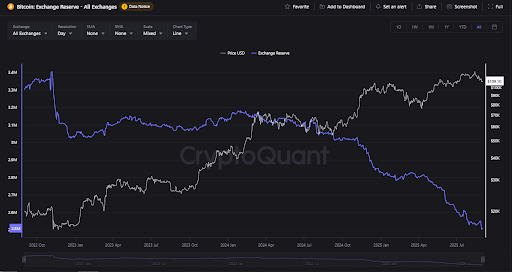Businesses are buying Bitcoin four times faster than miners create it, and are draining exchange reserves. What implications could this have on prices?
Bitcoin’s supply appears to be tightening as businesses start to absorb Bitcoin at a pace far beyond mining output.
According to data from financial services firm River, companies and institutions are buying nearly four times more Bitcoin than miners add to circulation.
This year alone, these companies have bought an average of 1,755 BTC per day. Miners, on the other hand, only produced about 450 new BTC each day. Exchange-traded funds (ETFs) added another 1,430 BTC daily while governments contributed about 39 BTC.
The combined figure is now a lot more than 3,200 BTC purchased per day.
Businesses Absorb Bitcoin to Build Treasuries
Corporate treasuries are behind much of this absorption. Q2 of this year saw companies buy 159,107 BTC and push their total business holdings to around 1.3 million BTC.
Strategy, led by Michael Saylor, currently leads the charge with this activity. The firm controls 632,457 BTC, and is the largest known corporate Bitcoin holder worldwide according to BitcoinTreasuries.
Businesses are absorbing bitcoin at 4x the rate it is mined. pic.twitter.com/41N8KN6sen
— River (@River) August 27, 2025
Some analysts argue that Strategy’s pace of buying is similar to a “synthetic halving.” Strategy, by removing so much Bitcoin from circulation, is reducing effective supply in a way that is similar to Bitcoin’s programmed halving events.
Despite the scale of its purchases, Strategy says that it avoids distorting markets with its Bitcoin buys.
Exchange Reserves Reach Multi-Year Lows
The absorption trend is visible in exchange data. Analytics platform CryptoQuant shows that Bitcoin exchange reserves currently sit at multi-year lows.

Coins moving from exchanges into treasuries or cold storage are effective at reducing liquidity. Once in cold storage, Bitcoin becomes inaccessible for short-term trading.
This structural change indicates that buyers are holding for the long term rather than speculating.
Spot Bitcoin ETFs are also contributors to this trend. These funds now hold more than 1.3 million BTC, and are locking up a major portion of the available supply. When combined with corporate treasuries, the effect reduces the float of coins that are accessible on exchanges.
Supply Metrics Show Structural Changes
Other on-chain metrics also support the idea of growing maturity in Bitcoin markets. The Network Value to Transaction (NVT) ratio fell 23% to 23.7 in recent months.
For context, a lower NVT shows healthier transaction activity relative to Bitcoin’s market cap.
Current mining output is still steady at about 450 BTC per day after the latest halving event. Considering how block rewards are programmed to shrink every four years, this number is expected to continue falling.
If institutional accumulation continues to hold, future halvings could increase supply shortages. Analysts believe that this imbalance may increase volatility but also speed up Bitcoin’s scarcity narrative.
Outlook for Bitcoin Supply
Companies absorbing Bitcoin faster than miners produce it show a major change in the market. Now with corporate treasuries and ETFs locking up coins, the pool available for daily trading continues to shrink.
~1.3 million bitcoin ($150 billion) are held by businesses.
Companies are starting to catch on after 16 years of front-running by individuals. pic.twitter.com/J0gTDovory
— River (@River) August 28, 2025
Whether this trend drives price higher depends on how demand grows (or shrinks) from here on out. If buyers maintain their current accumulation trends, exchange liquidity could tighten further.
That scenario may increase volatility while strengthening Bitcoin’s reputation as a scarce asset.
For now, institutional accumulation appears to be steady. The balance between mining output and institutional buying indicates that Bitcoin’s supply dynamics are entering a new phase:
One that is defined by long-term holders, rather than short-term traders.





